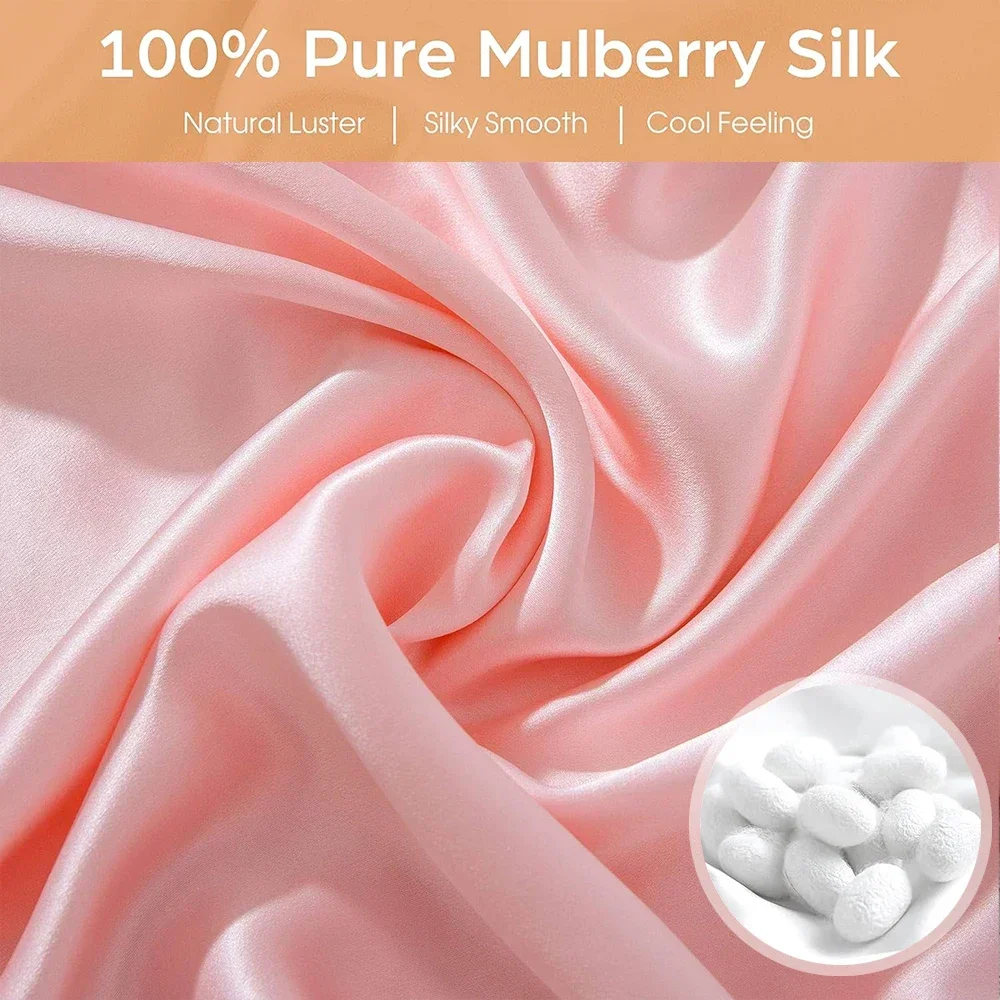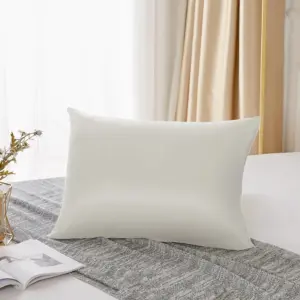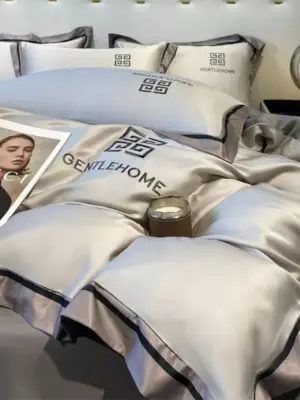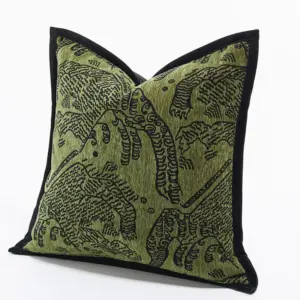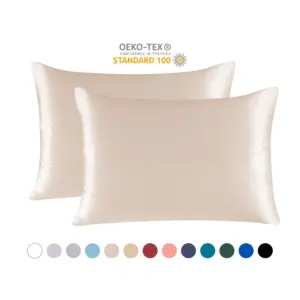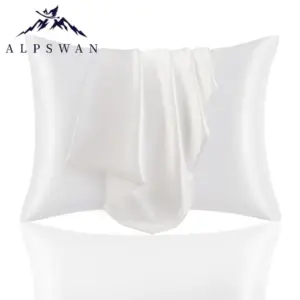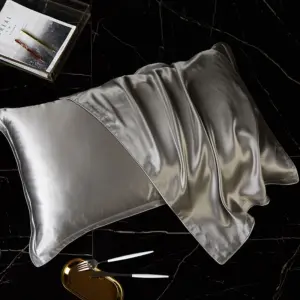Why Your Cotton Pillowcase Is Secretly Damaging Your Hair
Most of us don’t realize that the cotton pillowcase we sleep on every night is actually causing significant damage to our hair. While cotton feels soft to the touch, its fibers create a rough surface at the microscopic level that works against your hair health in multiple ways.
Cotton pillowcases create up to 43% more friction against hair than silk alternatives. This increased friction doesn’t just make your hair frizzy – it actively breaks down hair strands night after night. As you toss and turn during sleep, your hair rubs against this rough surface, creating the perfect conditions for breakage and split ends.
Beyond friction, cotton is highly absorbent, pulling moisture from your hair while you sleep. It can absorb up to 27% of applied hair products and natural oils that your hair needs to stay healthy. This leaves your hair dry, brittle, and more prone to damage by morning.
Other ways your cotton pillowcase may be harming your hair:
- Creating frizz and tangles by catching individual strands
- Disrupting carefully styled hair, requiring daily restyling
- Pulling and tugging on fragile strands, causing them to snap
- Drying out your scalp, potentially leading to increased oil production
Switching your pillowcase material represents one of the most overlooked yet impactful changes you can make to your hair care routine. Understanding the differences between silk and cotton pillowcases for hair can significantly impact your hair’s health and appearance.
The Science-Backed Benefits of Silk Pillowcases for Hair Health
Dramatically Reduced Friction
The primary way silk pillowcases benefit your hair is by creating significantly less friction than cotton or other materials. With up to 43% less friction against your strands, silk allows hair to glide across the surface rather than catch and pull. This smoother interaction reduces hair breakage and prevents split ends from forming, particularly important for weakened or processed hair.
Superior Moisture Retention
Unlike cotton’s highly absorbent nature, silk maintains your hair’s natural moisture balance. The protein structure of silk helps your hair retain essential hydration overnight, preventing the dryness that leads to frizz and brittle strands. This moisture preservation is particularly beneficial during winter months or in dry climates when hair is more vulnerable to dehydration.
Preservation of Natural Oils and Products
The smooth surface of silk doesn’t strip away your natural scalp oils or absorb expensive hair products. Dermatologists note that this preservation of natural oils contributes to overall scalp health while allowing treatment products to work fully on your hair rather than transferring to your pillowcase.
Minimized Tangling and Bedhead
Silk’s frictionless surface dramatically reduces the morning bedhead struggle many people face. Hair strands slide across the pillow rather than catching and knotting, meaning fewer tangles to brush through and less damage from trying to work through those knots.
Extended Hairstyle Longevity
Blowouts, curls, and other styled looks last noticeably longer when you sleep on silk. The gentle surface maintains your style instead of crushing or disrupting it, potentially saving you significant styling time and reducing heat damage from daily restyling.
Hair Type-Specific Benefits
Different hair types receive unique benefits from silk pillowcases:
– Curly hair maintains definition and experiences less frizz
– Fine hair sees reduced breakage and volume loss
– Color-treated hair maintains vibrancy longer
– Chemically-processed hair receives extra protection for damaged cuticles
Healthier Scalp Environment
The proteins in silk (sericin and fibroin) create a healthier scalp environment by regulating temperature and reducing irritation. This balanced environment supports optimal hair growth from the follicle level.
Understanding What Makes Silk Special for Hair Protection
The exceptional hair protection that silk provides comes from its unique physical and chemical structure that sets it apart from all other fabrics. At the microscopic level, silk fibers display remarkable properties that directly translate to hair benefits.
Silk fibers are extraordinarily long and smooth – a single silk fiber can measure up to 1,000 meters in length without breaks. This creates an uninterrupted, sleek surface that hair glides across without catching. When you examine silk and cotton under a microscope, the difference is striking: silk appears as smooth, continuous strands while cotton shows rough, irregular fibers with many catching points.
The natural composition of silk also plays a crucial role in its hair benefits:
- Silk contains 18 amino acids that are similar in structure to those found in human hair
- These protein components create a natural affinity with hair, reducing static and friction
- Silk fibers are less porous than cotton, helping maintain hair’s moisture balance
- The natural hypoallergenic proteins in silk don’t irritate the scalp or cause adverse reactions
The molecular structure of silk creates a surface that reflects light rather than absorbing it, which contributes to hair appearing shinier after regular use of silk pillowcases. Understanding these fundamentals of silk weaves in bedding helps explain why silk provides such superior results compared to other fabrics.
Unlike synthetic materials that attempt to mimic silk’s smoothness, real silk contains natural proteins that work harmoniously with human hair. This biological compatibility is impossible to replicate in man-made materials, regardless of how smooth they might feel to the touch.
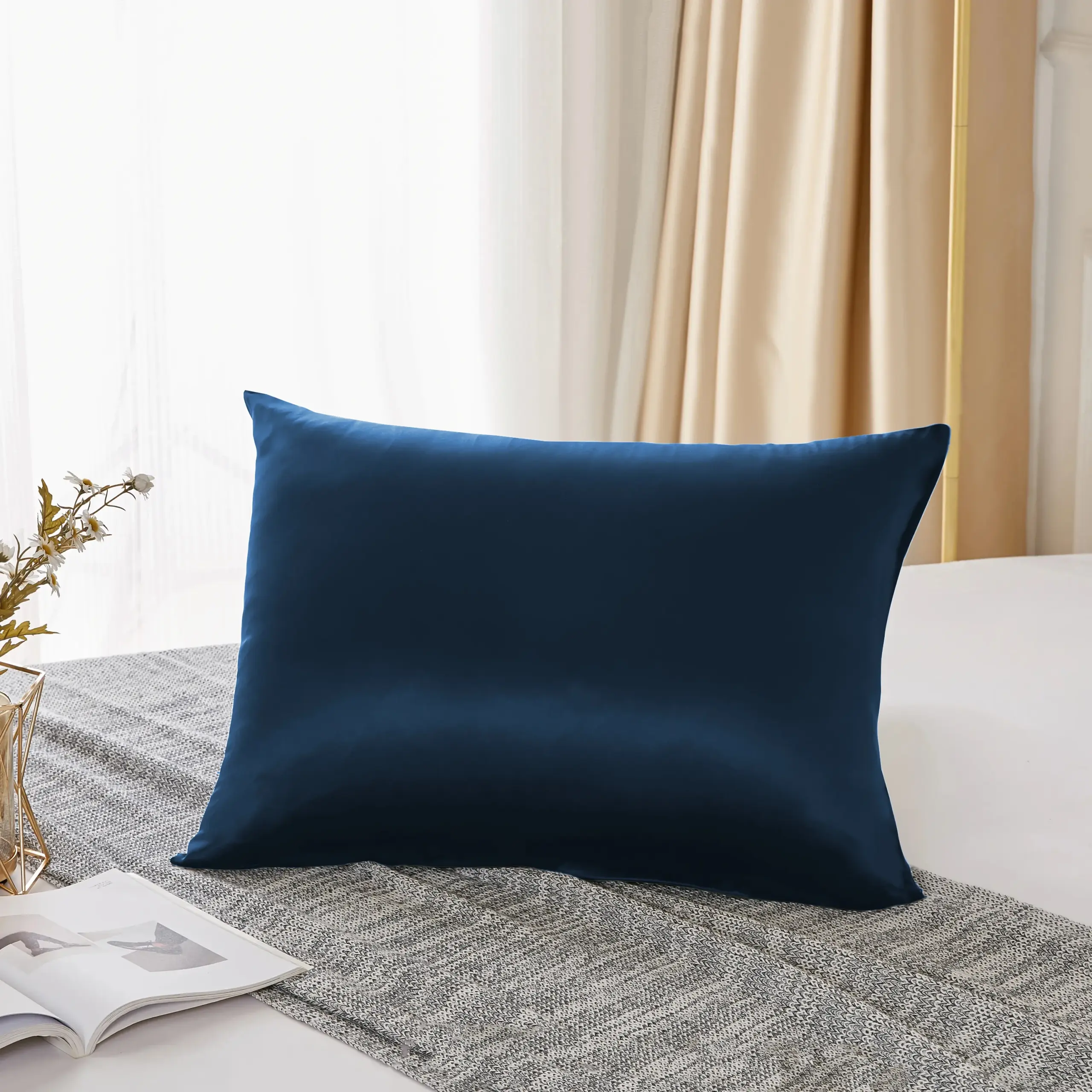
Silk vs. Cotton vs. Satin: A Comparative Analysis for Hair
When evaluating pillowcase materials for hair health, understanding the key differences between silk, cotton, and satin helps make an informed decision. Each material interacts differently with your hair, producing varied results overnight.
| Feature | Silk | Cotton | Satin |
|---|---|---|---|
| Friction Level | Very Low (0.1-0.3 coefficient) | High (0.5-0.8 coefficient) | Medium (0.3-0.5 coefficient) |
| Moisture Absorption | Low (retains hair’s moisture) | High (absorbs up to 27% of oils/products) | Medium (depends on material) |
| Temperature Regulation | Excellent (adjusts within 2°C of ideal) | Poor (traps heat or feels cold) | Moderate (depends on material) |
| Effect on Hair Breakage | Minimal breakage | Significant breakage risk | Reduced breakage compared to cotton |
| Durability | 2-3 years with proper care | 1-2 years | Varies widely by quality |
| Price Range | Higher investment ($50-200) | Low ($5-30) | Medium ($15-60) |
A common source of confusion is the difference between silk and satin. Silk is a natural fiber produced by silkworms, while satin refers to a weave pattern that can be made from various materials, including polyester, nylon, or silk. Satin made from polyester can provide some benefits over cotton due to its smoother surface, but it lacks silk’s natural properties:
- Polyester satin doesn’t contain the amino acids found in silk
- Synthetic materials can generate static electricity that disrupts hair
- Man-made fibers don’t regulate moisture the way natural silk does
In a detailed comparison between silk and cotton pillowcases, studies show that silk consistently outperforms both cotton and synthetic satin for hair protection. Hair strands show less cumulative damage when tested after sleeping on silk versus other materials, with particularly noticeable differences for curly, fine, or damaged hair types.
While satin pillowcases represent an improvement over cotton, true silk provides comprehensive benefits that synthetic alternatives simply cannot match. The natural protein structure of silk creates a biologically compatible surface that works harmoniously with hair to preserve its health and appearance.
Choosing the Right Silk Pillowcase for Maximum Hair Benefits
Selecting the ideal silk pillowcase requires understanding several key quality indicators that directly impact hair benefits. Not all silk pillowcases are created equal, and knowing what to look for ensures you’ll get maximum hair protection from your investment.
Understanding Momme Weight
Momme (mm) weight measures silk fabric density and quality, similar to thread count in cotton. For optimal hair benefits, the sweet spot lies in the 19-25 momme range:
– 19-21 momme: Good balance of softness and durability
– 22-25 momme: Premium quality with excellent longevity and maximum smoothness
– Below 19 momme: Too thin for long-term hair benefits
– Above 25 momme: Often unnecessarily heavy without additional hair benefits
Understanding how to choose silk pillowcases by momme weight helps ensure you’re getting the right density for both hair protection and durability.
Pure Mulberry Silk Quality
100% pure Mulberry silk represents the highest quality silk available. This premium material comes from silkworms fed exclusively on mulberry leaves, producing longer, more uniform fibers with superior smoothness. Look for Grade 6A Mulberry silk for the ultimate in hair protection, as this grade offers the longest individual fibers and most consistent texture.
Important Certifications
Quality silk pillowcases should carry the OEKO-TEX Standard 100 certification, guaranteeing the material is free from harmful substances that could transfer to your hair and skin. This certification ensures the dyes and processes used meet strict safety standards.
Optimal Weave Structure
The charmeuse weave is ideal for hair protection, featuring a satin finish on one side with a matte finish on the other. This structure maximizes the smooth surface area that contacts your hair while maintaining durability. Avoid crepe de chine or habotai weaves for pillowcases, as they don’t provide the same level of smoothness.
Practical Considerations
When shopping for the perfect Mulberry silk pillowcase for hair protection, also consider:
– Size compatibility with your pillows (standard, queen, or king)
– Closure type (envelope, zipper, or button) to keep pillow secure
– Color (darker colors require more processing but hide oils better)
– Price range expectations ($50-$150 for genuine quality options)
How to Properly Care for Your Silk Pillowcase
Maintaining your silk pillowcase properly ensures it continues providing optimal hair benefits for years to come. With simple care routines, you can preserve the smooth surface and natural properties that protect your hair.
Washing Guidelines
- Frequency: Wash every 7-10 days to remove natural oils and product buildup
- Water temperature: Use cold or lukewarm water only (never above 86°F/30°C)
- Detergent: Choose pH-neutral, enzyme-free silk detergents or gentle shampoo
- Technique: Hand wash gently by soaking and lightly agitating, or use washing machine’s delicate cycle in a mesh laundry bag
Drying and Pressing
- Never wring silk, as it damages the fibers
- Remove excess water by pressing between clean towels
- Air dry away from direct sunlight
- If ironing is necessary, use the lowest silk setting and place a thin cloth between the iron and silk
Extending Pillowcase Life
- Rotate between two standard size silk pillowcases to extend their lifespan
- Keep facial products completely absorbed before laying on your pillowcase
- Avoid sleeping with wet hair, which can transfer excessive moisture to the silk
Common Care Mistakes to Avoid
- Using regular laundry detergent (too harsh for silk fibers)
- Putting silk in the dryer (heat damages protein structure)
- Using bleach or stain removers (destroys silk’s natural properties)
- Exposing to prolonged sunlight (causes fading and weakens fibers)
Proper maintenance not only extends the life of your investment but ensures the surface remains optimal for hair protection. The smooth fiber structure that reduces friction can be compromised by improper washing methods, so following these guidelines preserves the hair-protecting qualities you purchased the silk pillowcase for in the first place.
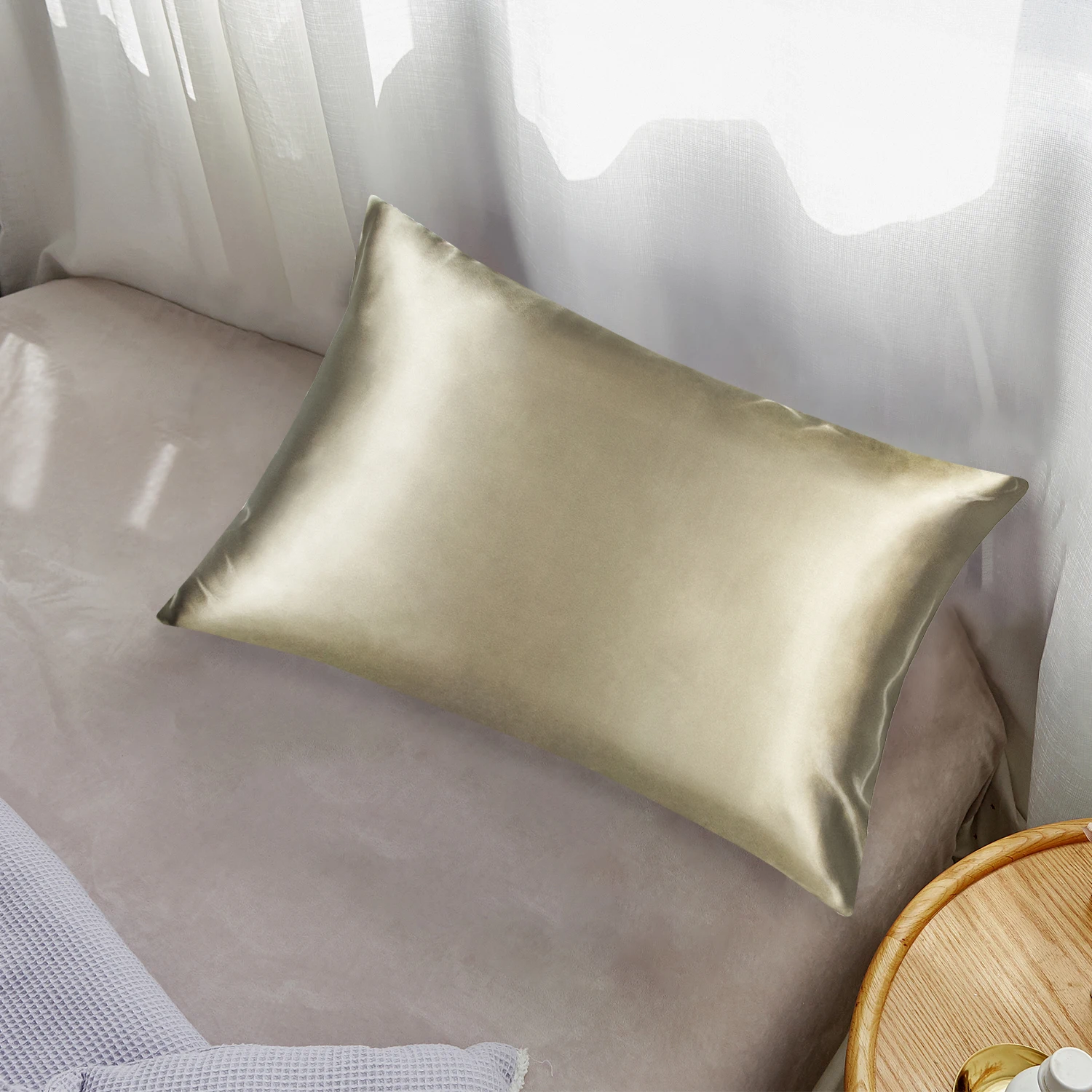
Specific Hair Types and How They Benefit from Silk
Different hair types experience unique benefits from sleeping on silk pillowcases, with each texture and condition gaining specific advantages from the smooth surface and natural properties.
Curly and Coily Hair
Curly hair gains perhaps the most dramatic benefits from silk pillowcases:
– Preserves curl pattern and definition overnight
– Significantly reduces frizz by minimizing disruption to cuticle layers
– Maintains moisture crucial for curl structure and elasticity
– Prevents the flattening effect that cotton causes on curl patterns
The specialized needs of curly hair care with silk pillowcases make them particularly valuable for maintaining natural texture without additional styling.
Fine or Thin Hair
Fine hair is especially vulnerable to damage from friction:
– Reduces the 30% increase in breakage fine hair typically experiences on cotton
– Preserves volume by preventing flattening and compression
– Minimizes oil distribution that can make fine hair appear limp
– Helps maintain root lift and body overnight
Color-Treated Hair
Processed hair benefits from silk’s gentle protection:
– Reduces color fade by up to 25% compared to cotton pillowcases
– Preserves moisture in hair that’s already compromised from chemical processing
– Minimizes cuticle disruption that causes color molecules to escape
– Extends time between color treatments by maintaining vibrancy
Chemically-Processed Hair
Hair that’s been permed, relaxed, or otherwise chemically altered needs special protection:
– Creates a gentle environment for weakened protein structures
– Prevents additional stress on already compromised hair bonds
– Reduces breakage along points of weakness from chemical processing
– Helps maintain treatments longer by reducing mechanical stress
Straight Hair
Even straight hair sees significant improvements:
– Dramatically reduces static and flyaways common with cotton
– Prevents the “bent” or kinked look that happens overnight
– Maintains natural shine by preserving hair’s cuticle alignment
– Reduces tangles that straight hair is prone to during sleep
Regardless of your specific hair type, browsing our collection of silk pillowcases will help you find the perfect option to address your hair’s unique needs.
Real Results: What to Expect When Switching to Silk
When transitioning from cotton to silk pillowcases, you’ll notice both immediate and progressive improvements in your hair’s health and appearance. Understanding the timeline of benefits helps set realistic expectations.
Immediate Benefits (First Night)
After just one night sleeping on silk, you can expect:
– Noticeably less bedhead and fewer sleep creases in hair
– Reduced morning frizz, especially for curly or wavy hair types
– Up to 50% less styling time needed in the morning
– Hair that feels softer to the touch upon waking
Short-Term Benefits (First Week)
Within the first week of consistent use:
– Decreased frizz throughout the day, not just in the morning
– Better retention of hair products and natural oils
– Less tangling throughout the day
– Reduced static, particularly noticeable in dry climates or winter
Medium-Term Benefits (First Month)
After about a month of sleeping on silk:
– Visible reduction in breakage, especially around the hairline
– Improved overall shine and light reflection
– Heat styling needs reduced by up to 40%
– More consistent hair texture and behavior day-to-day
Long-Term Benefits (3+ Months)
With continued use beyond three months:
– Measurable reduction in split ends
– Healthier new growth emerging from scalp
– More consistent curl pattern and definition for curly hair
– Improved overall hair elasticity and strength
It’s important to maintain realistic expectations about what silk pillowcases can achieve. While the transformative effects of silk on hair during sleep are significant, they work best as part of a comprehensive hair care routine. Silk pillowcases complement proper hydration, regular trims, and appropriate product use rather than replacing these practices.
Most users report that by the three-month mark, the improvements in their hair condition make the investment in quality silk pillowcases clearly worthwhile. The cumulative effects of reduced friction and preserved moisture create progressively healthier hair over time.
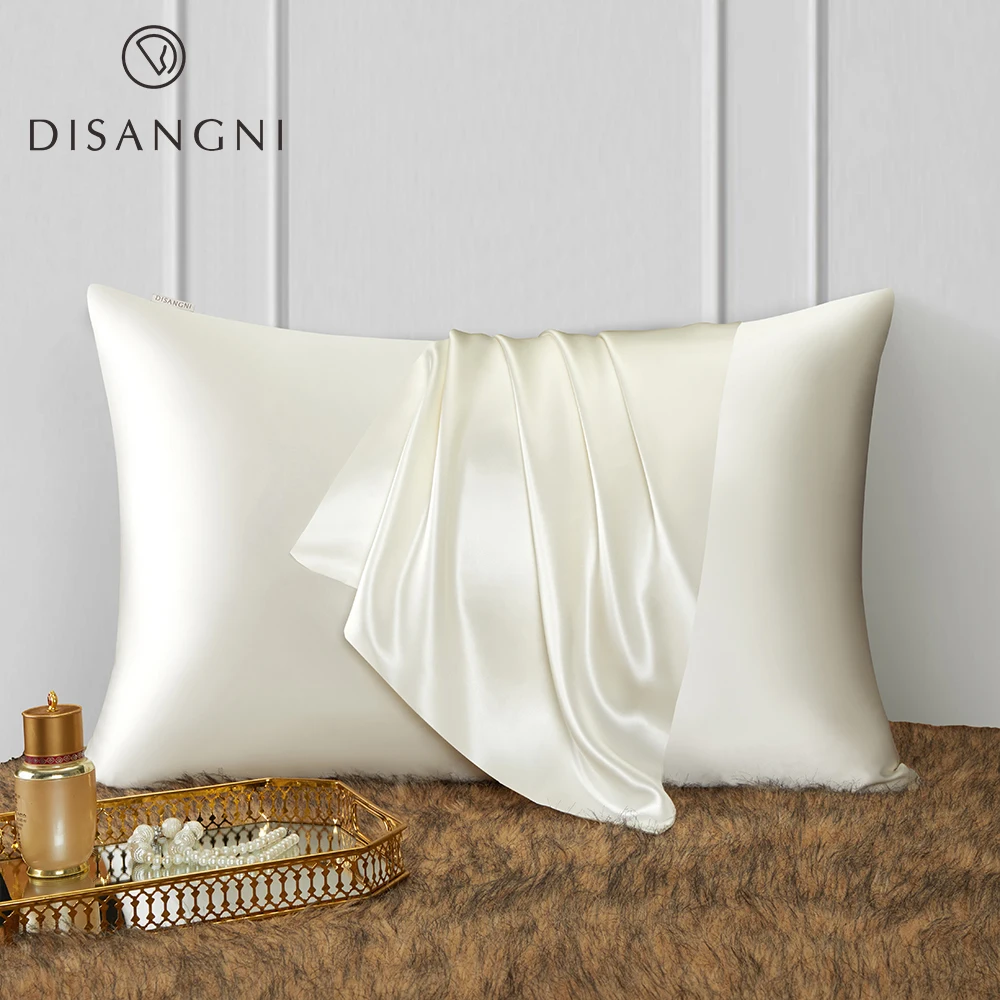
Beyond Hair: Additional Benefits of Sleeping on Silk
While hair protection may be your primary motivation for switching to silk, these luxurious pillowcases offer multiple additional benefits that enhance your overall sleep experience and well-being.
Skin Benefits
Silk’s smooth surface creates 43% less friction on facial skin compared to cotton, providing significant advantages for your complexion:
– Reduced formation of sleep creases and wrinkles
– Decreased irritation for sensitive or acne-prone skin
– Better retention of nighttime skincare products
– Less bacteria buildup due to silk’s natural resistance to microorganisms
The natural properties of silk for sensitive skin make it an excellent choice for anyone concerned with both hair and skin health.
Superior Temperature Regulation
Silk naturally regulates temperature within approximately 4°F (2°C) of ideal sleeping conditions:
– Keeps you cooler in summer months by wicking away moisture
– Provides gentle warmth during colder weather
– Creates a consistently comfortable sleep surface year-round
– Reduces night sweating that can damage hair and skin
Hypoallergenic Properties
Many sleepers with sensitivities find relief with silk:
– Naturally resistant to dust mites, mold, and mildew
– Doesn’t trigger reactions in most people with textile allergies
– Creates a cleaner sleeping environment with fewer irritants
– Particularly beneficial for those with eczema or dermatitis
Long-Term Value
While the initial investment in quality silk pillowcases like our queen size silk pillowcases is higher than cotton, the durability and benefits provide excellent value over time:
– Average lifespan of 2-3 years with proper care
– Reduces need for hair repair treatments and products
– Maintains appearance and performance longer than cotton alternatives
– Provides daily luxury that enhances sleep quality
King Size Silk Pillowcases, Mulberry Silk Pillowcases, Queen Size Silk Pillowcases
Price range: $94.96 through $121.56 Select options This product has multiple variants. The options may be chosen on the product page100% Silk Sheets, Queen Size Silk Fitted Sheet, Queen Size Silk Pillowcases, Queen Size Silk Sheets
Price range: $259.05 through $284.13 Select options This product has multiple variants. The options may be chosen on the product pageQueen Size Silk Pillowcases, Standard Size Silk Pillowcases
Price range: $121.49 through $127.57 Select options This product has multiple variants. The options may be chosen on the product page100% Silk Sheets, Mulberry Silk Pillowcases, Mulberry Silk Sheets
Price range: $105.03 through $121.45 Select options This product has multiple variants. The options may be chosen on the product pageStandard Size Silk Pillowcases
$76.72 Select options This product has multiple variants. The options may be chosen on the product pageMulberry Silk Pillowcases, Standard Size Silk Pillowcases
Price range: $64.60 through $181.26 Select options This product has multiple variants. The options may be chosen on the product page
Common Questions About Silk Pillowcases for Hair
Are silk pillowcases worth the investment for hair health?
When analyzing cost-per-use, silk pillowcases typically cost between $0.05-0.15 per night over their lifespan. Considering the reduced need for hair products, styling time, and heat damage repair, most users find the investment fully justified. Studies showing up to 43% less friction-related damage provide tangible evidence of their value for hair health.
How often should I wash my silk pillowcase?
For optimal hair and skin benefits, wash your silk pillowcase every 7-10 days. This frequency balances removing accumulated oils and products without excessive washing that might damage the silk fibers. Those with acne-prone skin or who use substantial hair products may prefer weekly washing.
Can silk pillowcases help reduce hair loss?
While silk pillowcases cannot prevent hair loss caused by genetic factors or medical conditions, they can reduce breakage that mimics hair loss. The reduced friction means fewer broken hairs on your pillow or in your brush, which may give the appearance of decreased hair loss for many users.
Will a silk pillowcase work for all hair types?
Yes, all hair types benefit from silk pillowcases, though in different ways. Fine hair experiences less breakage, curly hair maintains definition, straight hair reduces static, and processed hair retains moisture better. The fundamental properties of how silk helps hair apply universally, though results may vary in appearance.
What’s the difference between silk and satin pillowcases?
Silk is a natural protein fiber produced by silkworms, while satin refers to a weave structure that can be made from various materials (often polyester). True silk offers natural protein structures that benefit hair, temperature regulation, and hypoallergenic properties that synthetic satin cannot provide, despite a similar smooth appearance.
How long do silk pillowcases typically last?
Quality silk pillowcases, especially those in the 19-25 momme range, typically last 2-3 years with proper care, compared to cotton’s average 1-year lifespan. This makes king size silk pillowcases and other sizes an investment that provides returns over several years.
Are there any downsides to using silk pillowcases?
The primary considerations are higher initial cost and specific care requirements. Some users find silk pillowcases may slide off pillows more easily than cotton (solved by envelope closures or zippers), and lighter colors can show oils more readily. However, most users find these minor inconveniences are far outweighed by the benefits.
How to Start Your Silk Pillowcase Hair Journey
Beginning your transition to silk pillowcases for healthier hair is simple with these practical steps:
First, select a high-quality silk pillowcase that matches your needs. Look for pure Mulberry silk in the 19-25 momme range with OEKO-TEX certification to ensure you’re getting genuine benefits. Consider your pillow size and preferred closure type when making your selection.
To maximize results from the start, establish a nighttime routine that works with your new silk pillowcase:
– Brush hair gently before sleep to remove tangles
– Consider loosely securing very long hair with a silk scrunchie
– Apply any leave-in treatments at least 30 minutes before bed
– Use a silk bonnet in addition to the pillowcase for maximum protection
Be consistent with your use of silk pillowcases to see progressive improvement in your hair’s condition. Most users report noticeable hair improvement within 2-3 weeks of regular use, with benefits continuing to accumulate over time.
Remember there may be a slight adjustment period as you get used to the different feel of silk compared to cotton. The slippery texture might take a few nights to feel natural, but most sleepers quickly adapt and come to prefer it.
Understanding the variety of pillowcase materials for healthy hair helps put your silk choice in context and reinforces the benefits you’ll experience. With patience and proper care, your silk pillowcase will become an essential part of your hair care routine, delivering healthier, more beautiful hair night after night.

